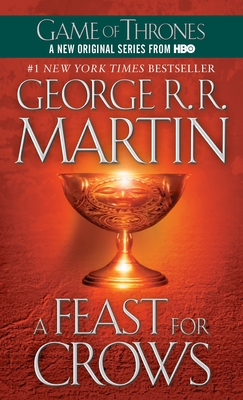This is a strange, “I’m halfway through a book and sort of feel like talking about it,” post, which is vague, because a) I’m only halfway through right now and I’m not a fan of saying, “Well, I think this might happen” or “This is what I like so far” because either of those things can change drastically in the second half of the novel and then here it is, all written down like a preemptive review of a full book even though it’s only half read and b) It’s part of a series, and I find those books difficult to write about, the ones that have something that comes before and something that comes after, only the book I’m dealing with comes somewhere in the middle. It carries a lot of baggage and SPOILERS and approximation.
It’s A Feast for Crows in George R.R. Martin’s A Song of Ice and Fire series. I really like this one. By far? It’s my favorite. But the thing is, I was dreading reading it. I was getting through A Game of Thrones and then A Clash of Kings and onto A Storm of Swords, and all the while, the fourth book was lurking in the background under a deluge of bad Amazon reviews and less-than-three-star ratings.
Reading A Feast for Crows reviews on Amazon put a small spotlight on the way my reading habits have evolved. When I was younger, I’d go into a bookstore and pick out a book. I’d maybe read the book jacket or the synopsis on the back, and sometimes I’d just look at the cover or the author or read a couple of pages and pick it that way. There were no book reviews online, or in a newspaper. Any recommendations came from in the store, or were passed hand-to-hand. They didn’t show up on Amazon as a “well, if you like this then you’re bound to like this because of a small logarithm or something similar that examines book sales and chooses the next best thing.” I would go in with no expectations. That’s how I came across A Game of Thrones. I watched the television show on HBO without knowing anything about it. Everything in the plot was a surprise. I was generally shocked by some of the things that happened, because I didn’t see them coming. And that was a really nice feeling.
But now I really rely on reviews. Partly, I think that’s come from undergrad and grad school English programs: “Here are the books that are good, take our word for it, etc. etc.” I stopped picking out books at random from the bookstore. I started looking for the things that people said were good or ranked as NUMBER ONE or showed up reviewed and rated.
So something kind of funny happened with A Feast for Crows. I read A LOT of bad reviews that said it was different than the rest of the books in the series, that it wasn’t as good as the others: if the books in the series were ranked, it came in last place, every time. And I started this slow dread of getting to the book. I read the first three more slowly. I bought four books and read them after finishing A Storm of Swords, and thought, “Okay, I’ll read all of these first and take a break from the series and then maybe I’ll be ready for the fourth book.” And so I did just that. I read the last four books reviewed on this blog: The 10 p.m. Question, Miss Peregrine’s Home for Peculiar Children, I Shall Wear Midnight, and The Love Curse of the Rumbaughs. And then I went to the bookstore and picked up A Feast for Crows.
And I loved it. Halfway in, I really can’t stop reading. You see, the books in A Song of Ice and Fire are told through a series of repeating viewpoints. Martin’s characters cycle through several perspectives that tackle the events taking place in the novel. There are a couple that I come across and I’m like, “Okay. Next. Moving on.” And then there are others where I want to stay with the character for the entire book, a kind of, “Swap all the perspectives for one. This one.” With A Feast for Crows, I love all of the character viewpoints. More than half of them are from female characters, and I think that makes a huge difference. Women in fantasy, and particularly women in a medieval fantasy series, have always interested me, particularly because of their ability to sort of subvert historical understandings of the same period. But this is the quickest I’ve read one of the books in the series, and I can’t really stop.
So, I’m going to get through. And then I think I’m going to go all “BUY THE HARDCOVER” and get A Dance With Dragons, the fifth book in the series that just came out in July. And I’m already doing the same thing to that one that I did with A Feast for Crows: I’m reading the reviews, and I’m judging it by the character perspectives that I already know will be in there. IT IS SUCH A HORRIBLE HABIT TO GET INTO. But maybe it will have the reverse effect again. I’ll think, “Hmm, maybe this won’t be that great,” and then it will be the best thing ever.







